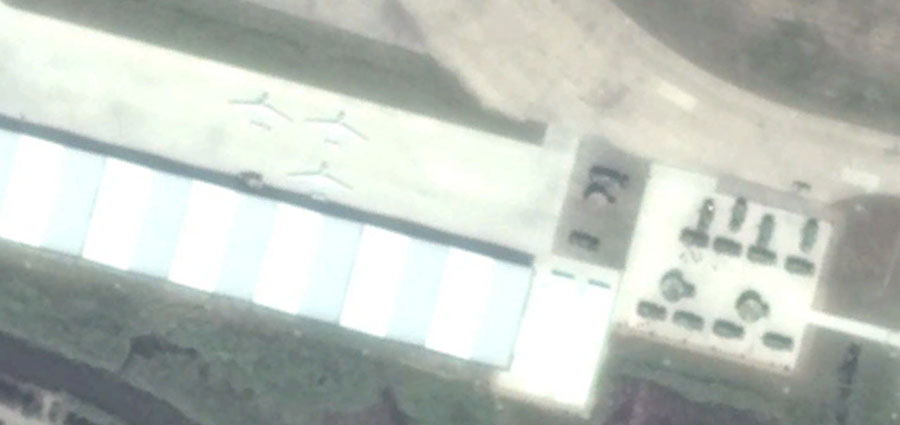
Robohub.org
The Drone Center’s Weekly Roundup: 7/6/15

Satellite imagery of Chinese drones at an airbase on Daishan Island. Via: Bellingcat.
At the Center for the Study of the Drone
Until the FAA implements comprehensive regulations for the commercial use of unmanned aircraft in US skies, the only companies legally permitted to fly drones are those in possession of a Section 333 exemption. We have compiled a comprehensive database of every company and individual with an exemption. This database offers the most detailed view to date of the emergent domestic commercial drone industry.
News
A US drone strike reportedly killed four people in southern Yemen. The strike targeted a vehicle leaving a former Yemeni army base near the port city of Mukalla. The dead are suspected of being members of al-Qaeda. (Agence France-Presse)
In a statement, the Pentagon announced that a US airstrike last month killed Tariq bin Tahar al-’Awni al-Harzi, a senior leader of ISIS. The strike, which was reportedly carried out by an American drone, took place on June 16 in Shaddadi, a northeastern Syrian city near the Iraqi border. Harzi helped move money, equipment, and fighters into Syria and Iraq. (Washington Post)
The United States is reportedly operating drone surveillance and reconnaissance flights out of an airstrip near Kismayo, Somalia. According to Foreign Policy, the outpost is part of an expanded US military presence in the Horn of Africa. The US has long based Predator and Reaper drones at an airfield just north of Somalia in Djibouti.
US Congressman Dan Lipinski (D-IL) introduced the Future Transportation Research and Innovation for Prosperity (TRIP) Act, a bill that would fund research into ways that drones could help solve transportation challenges. (Chicago Tribune)
Meanwhile, US representatives Kyrsten Sinema (D-AZ) and Duncan Hunter (R-CA) introduced legislation that, if passed, would create an “interagency working group to develop best practices for integrating Unmanned Aircraft Systems (UAS) technologies into wildland firefighting efforts.” (Press Release)
In Tennessee, a new state law that bans flying drones over fireworks displays has taken effect. A video of a fireworks display in Nashville last year received almost 100,000 views on YouTube. The offense is punishable by up to 30 days in jail and a $50 fine. (News2)
At Seattle’s Pride parade, a woman was knocked unconscious by a drone. The woman was standing on a corner when the small drone crashed into a building and fell on her. The operator of the aircraft has since come forward to police. (Seattle Times)
The US Navy appointed Rear Adm. Robert P. Girrier to be its first director of unmanned weapon systems. The new directorate will be part of the Office of the Chief of Naval Operations and will coordinate the Navy’s programs to develop undersea, air, and surface unmanned vehicles. (USNI News)
The Air Force Times reports that a US Predator drone that crashed in Syria in March was shot down following a series of mistakes by the crew. According to a US European Command spokesperson who spoke with AF Times, the aircraft was lost as a result of “inconsistencies in command and control guidance and mission approval processes.”
Kansas State University-Salina plans to offer a Bachelor of Engineering Technology degree in unmanned aircraft. The degree, which will mainly focus on how to fly drones, will include studies in computer science and electronic and mechanical engineering. The university also plans on adding two minors for drone studies. (Daily Record)
Commentary, Analysis, and Art
At the Daily Beast, Pierre Vaux writes that footage from a drone lends credence to the argument that Russian army regiments are engaging in the conflict in eastern Ukraine.
At Bellingcat, Chris Biggers reports that new satellite imagery reveals a Chinese drone base on Daishan Island, near the East China Sea.
At Wired, Molly McHugh considers the consequences of flying a drone near fireworks.
Meanwhile, at Chicago Magazine, Adrienne Hurst also takes a look at what might happen to a drone if it were to collide with a firework.
At Fortune, Matt McCue takes a look at the careers of four women who are shaping the drone industry.
The “Artificial Killing Machine,” an exhibition by Jonathan Fletcher Moore, marks each US drone strike by firing a cap gun. (Fast Company)
At Just Security, Adil Ahmad Haque argues that the Pentagon’s new Laws of War Manual advances a skewed understanding of the principles of proportionality and distinction.
A Stratfor briefing argues it’s likely that many militaries around the world will begin developing hybrid drone systems that can perform some functions without a human operator.
The Uplink
In The Uplink, we ask an expert, policy maker, or insider to comment on a current event in the world of drones.
On June 24, The New York Times and the Guardian reported that documents leaked by Edward Snowden reveal new insights into President Obama’s targeted killing program. What do these documents tell us that we didn’t know before, and why is this new information significant?
Scott Shane, National Security Reporter at The New York Times:
At the New York Times we have only a subset of the Snowden documents, courtesy of the Guardian, but they make clear how large a role SIGINT, or signals intelligence, the technical term for eavesdropping, plays in targeting strikes. This is no surprise when you realize that everyone carrying a cellphone is broadcasting his location. And the documents suggest that targeters have realized how easy it is to make a mistake by relying strictly on an electronic signal, because a phone used by an al-Qaeda leader today may be used by his young niece tomorrow. So the documents discuss the need to corroborate the identity of the guy with the phone, by observing him from the air, listening to the content of his calls and so on. Then there was the macabre note that if at the moment of a missile strike a target “detached” from communications – that is, if his phone call suddenly was cut off – that is “a good indication that the correct target has been struck.” That brought to my mind what must be a contrary scenario: that the missile hits and the targeters hear the person the strike was meant to kill calmly talking away. That would obviously mean the missile has hit the wrong person. For drone operators, that must be a horrible moment.
Know Your Drone
Defense company Kalashnikov Group will unveil a fleet of drone-equipped assault boats. (Sputnik News)
A consortium of French and British companies is developing a system that can detect and track a small drone from up to 5 nautical miles away, and even locate the drone’s operator. (Flight Global)
Amazon is reportedly scanning certain properties in Seattle in preparation for its drone delivery program. (Forbes)
The US Marines is testing a system that turns a small reconnaissance drone into a communications relay device, allowing soldiers to communicate further across the battlefield. (Defense Systems)
NASA is developing a small unmanned glider to survey the martian landscape during the first manned mission to Mars. (Engadget)
An Israeli company has developed a low-cost, 3G-based delivery drone. (Gizmag)
Drones at Work
A drone was used to carry a lifejacket to two boys who were stranded in the middle of a river in Maine. (ABC News)
Police in Madison, Wisconsin used a drone to help find a car thief who was hiding in a marsh. (Wisconsin State Journal)
The Dutch government used three drones to help control traffic at a festival in Zeeland. (Press Release)
China reportedly deployed a drone to assist in search-and-rescue efforts after an earthquake in Xinjiang, a province in western China. (Reuters)
Utility companies in the United States are experimenting with using drones to inspect power lines. (Associated Press)
The Michigan Aerospace Manufacturers Association is working with the government of Ghana to create a network of drones that will ferry medicine and supplies to difficult-to-reach areas. (UAS Magazine)
The Weekly Drone Roundup is a newsletter from the Center for the Study of the Drone. It covers news, commentary, analysis and technology from the drone world. You can subscribe to the Roundup here.
tags: c-Aerial, drones, UAVs




